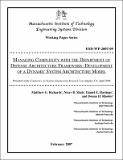| dc.description.abstract | Architecture frameworks are tools for managing system complexity by structuring data in a common language and format. By characterizing the form, function, and rules governing systems, architecture frameworks serve as a communication tool to stakeholder communities with different views of the system and facilitate comparative evaluation across architectures. The goal of this research is to explore the applicability of architecture frameworks to the study of emergent properties of satellites. The U.S. Department of Defense Architecture Framework was selected to achieve this goal given its orientation towards technical systems in contrast to the majority of architecture frameworks focused on business enterprises. Although developed by military planners in the 1990’s to support the acquisition of interoperable information systems, the Department of Defense Architecture Framework can be used to connect operational concepts and capabilities to the technical architecture of any system. While the views of the Department of Defense Architecture Framework are well-defined, little guidance is provided on how the views are to be constructed. Vitech Corporation’s software program CORE,® a systems engineering modeling tool with the ability rapidly to produce architecture views from a common data repository, was employed to complete Department of Defense Architecture Frameworks for the Hubble Space Telescope.
Upon characterizing Hubble within this common structure, the value of the Department of Defense Architecture Framework for conducting dynamic quantitative analyses of system architectures was explored. A methodology is proposed and tested for evaluating human and robotic architectures for on-orbit servicing—the extension of the useful life of spacecraft through refueling, upgrading, repair, relocation, et al. In particular, a multi-year servicing campaign is modeled for Hubble including behavioral threads that characterize the Orbiting Observatory, servicing architecture, and science customers. Preliminary results indicate that, when coupled with an executable model, the Department of Defense Architecture Framework can be utilized for dynamic quantitative evaluation of space system architectures. The paper concludes with lessons learned from using the Department of Defense Architecture Framework and proposes improvements for the application of its static views to model-based systems engineering. | en_US |
